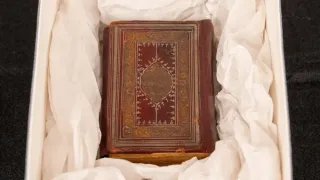January 27, 2016
Oscar Wilde Tours' Shady Ladies of the Metropolitan Museum
Winnie McCroy READ TIME: 4 MIN.
Tackling the impressive offerings that The Metropolitan Museum of Art displays can be intimidating for the most informed art lovers among us. For a newcomer, it can be downright daunting. Enter Andrew Lear of Oscar Wilde Tours. With tours like "Gay Secrets" or "Shady Ladies of the Met," Lear focuses on works of art that might be interesting to niche audiences like the LGBT community, and explains them in a fun and interesting way.
A quick glance through The Met's offering may have you thinking it's full of nudes. But back in the day, artists couldn't depict everyday women nude. Instead, they had to couch their depictions of nudes in classical scenes pulled from mythology, like Pompeo Batoni's "Diana and Cupid."
"People look at art in a very funereal way, but in reality it's loaded with sex," said Lear. "The themes are very erotic, and people used any excuse to depict them. For example, there were no nude statues of females until late in the Classical Era, but eventually they got away with it by depicting an Amazon, with her breast bared and wounds all over."
In the past, noble women were not expected to be educated or even interesting. Instead, men turned to courtesans or mistresses called hetaira to find a woman who was educated, trained in acting, musical instruments or song, and sexually adventurous, even liberated.
"The women depicted in this art were feminists, of a sort," said Lear. "The women who were most liberated were the high-class sex workers. There was no room for emotion in high-class marriages, but prostitutes could have an education, political power, and an active sex life."
These hetaira gathered with men for "symposiums," late-night drinking parties held in the ancient equivalent of a "man-cave," a room at the front of a home reserved for noblemen to enjoy wine and women. The goings-on are captured via saucy scenes on wine vases from the Ancient Greece collection, ranging from Dionysus and satyrs to wild women and lesbians.
It can sometimes be hard to understand what we are seeing when we look at art. For example, why is Cupid peeing on Venus through a myrtle wreath in Lorenzo Lotto's "Venus and Cupid?" And why are Manet's ballerinas racy? Lear knows that these seemingly docile "ballerinas" were never paid very much, instead exchanging sexual favors with wealthy sponsors or patrons to keep them in toe shoes.
Another way to incorporate nudes in painting was via "genre scenes" of everyday life. The Dutch favored images of sitting rooms where young prostitutes were often escorted in by a crone, who represented the madam. They also like scenes of debauchery, as in Jan Steen's "Merry Company on a Terrace." And in series of works like "A Rake's Progress" by William Hogarth, a rich miser dies, and his son quickly goes about dispatching his father's wealth, ditching his pregnant girlfriend in favor of wine and loose women.
Lear points out sexy depictions of women from artist like Titian, Manet and Sargent. Often, the models were these shady ladies. Mme. De Pompadour, the most powerful mistress of the ancient regime, inspired the painting "The Toilette of Venus." Even when King Louis XV grew tired of her, she remained the royal mistress at Versailles.
Even these ordinary women stand the history of time. Thomas Gainsborough brought Mrs. Grace Dalrymple Elliott to life, as she was "of great beauty but easy virtue," even having a brief affair with the Prince of Wales. Manet depicted female painter Victorine Meurent in eight portraits, including an allegory of the five senses. And lesbian actress Elizabeth Farren, painted by Sir Thomas Lawrence, elevated her status by marrying up, becoming Countess of Derby.
"We look at the Victorian Era as very prim and proper, but really it was because they were trying to get out from under the whoredom of their past relatives," joked Lear.
Eventually, artists began portraying ordinary people, to scandalous result. Gustave Courbet was excoriated for portraying real women, imperfections and all, engaged in their own pursuits. And lesbian artist Rosa Bonheur painted such muscular paintings like "The Horse Fair" that the government gave her express permission to wear men's clothes, which was at the time illegal.
The cherry on this sundae is, of course, John Singer Sargent's famously scandalous painting, "Madame X." Although both Sargent and Madame Pierre Gautreau agreed to the painting, once the public saw her in a low-cut dress with her daring trademark flourish -- one strap dangling off the shoulder (Sargent later painted over this) -- and the model's lilac-powdered skin, all hell broke loose. That she was depicted with her body facing the artist and her head turned away cemented the claims of immodesty.
The Paris Salon accused Gautreau of "insufficient decency," which destroyed her reputation. Her family tried, unsuccessfully, to withdraw the painting. Thirty years later, Sargent eventually sold it to The Met, saying, "I suppose it is the best thing I have done." We agree.
Guests are welcome to take photographs without flash (no videos), and all backpacks and umbrellas must be checked. Oversized items and luggage are not permitted.
Shady Ladies of the Metropolitan Museum will be held at 6 p.m. on Friday, Feb 12 at the Metropolitan Museum of Art, 1000 Fifth Ave. in New York, NY 10028. Tickets are $27.37-48.47, includes museum admission. For information, email [email protected]. For tickets, visit https://www.zerve.com/OWTours/Ladies






